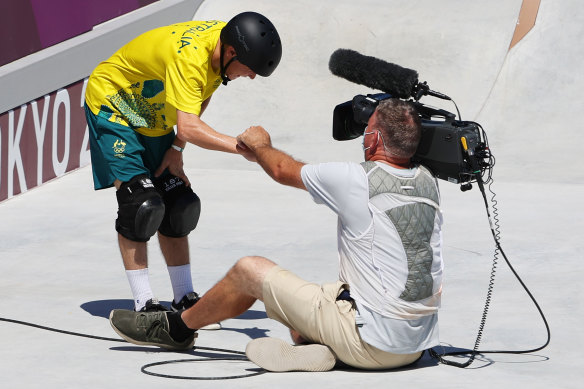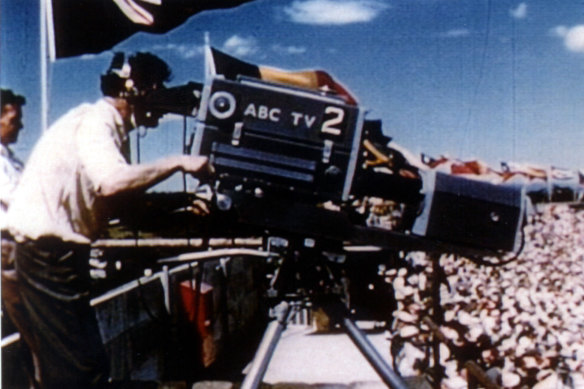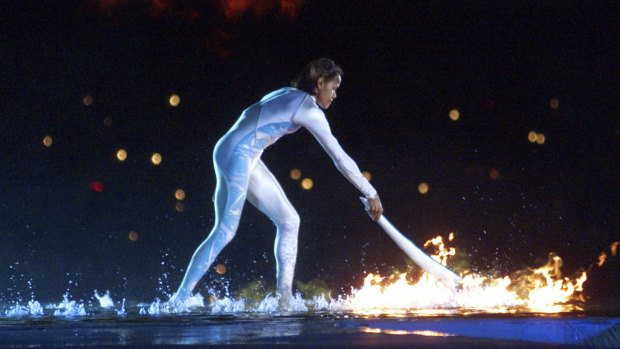An ancient athletics carnival, tailor-made for the digital TV era
In 1968, the Tanzanian runner John Stephen Akhwari cramped midway through the Olympic marathon and fell to the ground. Struggling to stand, he resumed the race, finishing an hour after the other competitors when just a few thousand spectators remained in the stadium. Captured by the television cameras, Akhwari said: “My country did not send me 10,000 miles just to start the race; they sent me to finish the race.”
Such moments are the stuff that Olympic magic is made of. The quadrennial meet is the apotheosis of the sporting world, where mortals are transformed into gods, in the finest Greek tradition. The games themselves may be some 2800 years old, but they have only been televised for the last 87. Which is good, to be honest because before that, everyone competed in the nude and the TV cameras would not have known where to look.
Too close for comfort? Kieran Woolley checks on a TV cameraman he crashed into during the 2020 Olympic qualifiers.Credit:Getty
What is perhaps most extraordinary is the manner in which something so elegantly ancient – an athletics meet held in the shadow of a burning flame lit in front of the Temple of Hera in the ancient arena of Olympia, Greece – could be so perfectly tailor-made for digital television in the multichannel era. The organisers might make a fuss about the ticket sales every four years, but the best seat is literally in the house. Mine, yours, everyone’s.
As if the Olympics were not themselves a monumental undertaking, the television broadcast is larger still. A technological framework that fits over a biological framework. From the first analog coaxial cables that ran images and sound to broadcast trucks, to the digital play-out centre of the modern era that feed hundreds of channels into packages of content, all controlled by the viewer, armed with a remote control.
Despite the technology, even when it was in its infancy, what sits at the heart of the power of the Olympics are captured moments of extraordinary achievement, when human bone, muscle and sinew, powered by indomitable will, are pushed beyond their engineering tolerances, and then slung down a television cable in the form of 625 interlaced lines, played at 25 frames per second.
It could be technological nonsense. It is, instead, television wizardry.
Television coverage of the 1956 Olympics from Melbourne.
Television was there when, in 1972 at the Munich Games, 22-year-old American swimmer Mark Spitz won seven gold medals. And in 1976, when 14-year-old Romanian gymnast Nadia Comaneci scored perfect 10s on the uneven bars. (A routine made even more surreal by the fact that she did so while performing to the theme from the American soap opera The Young and the Restless.)
Television was also there in 1984 in Los Angeles when 23-year-old track-and-field star Carl Lewis won gold for the 100m, 200m, 4 x 100m relay and long jump. And in 1988 in Seoul when diver Greg Louganis slammed his head into the diving board, suffering a concussion, and, just as it seemed his Olympic dreams had been shattered, followed it with a medal-winning springboard performance that snatched victory from the jaws of defeat.
And television was there in 2000, in Sydney, capturing Ian Thorpe, Michael Klim, Chris Fydler and Ashley Callus’s gold medal victory in the 4x100m freestyle swimming relay, four more gold medal wins for the then-barely-out-of-his-floaties 17-year-old Thorpe, a memorable silver medal for long-jumper Jai Taurima – “Long jump’s a pretty easy event. You just run 50 metres and jump. It’s not that hard,” he quipped – and gold for Cathy Freeman in the 400m, clocking in at an astonishing 49.11 seconds.
Cathy Freeman ignites the Olympic flame at the Sydney 2000 games.Credit:AP
These moments, when captured by the television cameras, are frozen in time, ageless and eternal. They are empowered by both intimacy and clarity. The camera’s power, the ability to take us into the moment is unrivalled, whether it was a cabled analog camera running slowly alongside a race in the 1970s, or underwater cameras that take us into the pool with the world’s present-day swimming champions.
So too is the ability to take us, in the digital multichannel era, to the four corners of the Olympic park at once. For the vintage viewer it can be discombobulating to watch coverage without curation, but there is something extraordinary about the power of a remote control when it can switch between simulcast sports, or indeed replay iconic moments over, and over, and over again.
Some of those moments sit ubiquitously at the heart of the media cyclone, while the world’s eyes are focused on the Olympics. Others, such as Simon Fairweather’s gold medal win in individual archery at the Sydney Games, are elevated by the television cameras, propelling a story that might not be seen by anyone but a home-town audience, onto the world’s stage. Television does that in a way that other media cannot.
Find out the next TV, streaming series and movies to add to your must-sees. Get The Watchlist delivered every Thursday.
Most Viewed in Culture
From our partners
Source: Read Full Article


